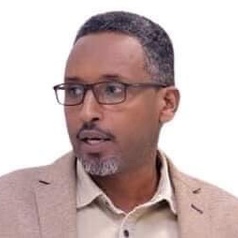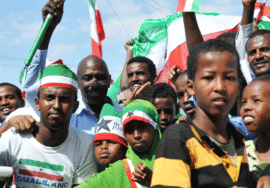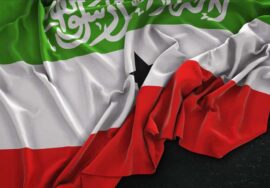
Nationalism, Consent & the State in Somalia
Nationalism, Consent & the State in Somalia
Introduction
Since the collapse of the Siyad Barre military dictatorship in January 1991, the southern part of the erstwhile Somali Republic (i.e. the ex-Italian Somalia) has become the living definition of a ‘failed state’ with the exception of the north-eastern part of the territory which has forged a functioning, clan-based government as the autonomous region of Puntland. By contrast, the ex-British Protectorate of Somaliland, having recovered the sovereignty and statehood it hastily, but voluntarily, ceded in 1960 in order to unite with ex-Italian Somalia to the south, has managed to establish the only functioning multi-party democracy in the Horn of Africa with a written constitution, separation of powers between the executive, a bicameral legislature and judiciary.
It is the position of this paper that the glaringly different outcomes to the collapse of the Siyad Barre dictatorship in the two segments of the erstwhile Somali Republic are rooted in the different experiences of colonial rule, the different perceptions of the nature of the state and consent thereto, and also to different impacts and importance of Somali nationalism and its attendant dream of Greater Somalia (Somaliweyn in Somali) in the two territories. This analysis focuses upon Somaliweyn as the underlying ethos that gave birth to the ill-fated union between the ex-British Protectorate of Somaliland (present day Somaliland) and the ex-Italian Colony of Somalia (or, to give it it’s legal name at that time, the UN Trust Territory of Somalia which was administered by Italy under a UN Mandate) and argues that a critical, and perhaps determining, cause of the opposite responses to the collapse of the state between the two territories is the former’s emphatic rejection of Somaliweyn in preference for alternative formulations of nationalism, and the latter’s continued fealty to this failed dream.
Of course, the eight hundred pound gorilla in this room is the role, machinations and preferences of regional and international powers in response to the collapse of the erstwhile Somali Republic. However, this paper is focused upon the internal drivers, i.e. the specifically Somali components, of Somaliland and Somalia that has resulted in their markedly different responses to the collapse of the military dictatorship in the erstwhile Somali Republic and to the efforts to re-establish the state in their respective countries. Hence, the role and machinations of the regional and international powers are not examined here in detail+, as they are not germane to this central discussion.
The Historical Background
The Somali people inhabit the land of the Horn of Africa (HOA) stretching from the coastline of the Red Sea as far north as Djibouti to the Indian Ocean as far south as the Northern Frontier District (NFD) of Kenya. Inland, the Somali inhabited territory stretches from Dire Dawa in eastern Ethiopia to Garissa in northern Kenya. The Somali people share a common language, culture, religion and ethnicity. While there are sedentary agriculturalists in the fertile region around the Juba and Shebelle rivers in the south, Somalis are principally pastoral nomads constantly migrating with their herds of livestock (primarily sheep, goats and camels, but also cattle) in a constant search for pasturage and water. The independent, self-reliant and sometimes fierce culture bred by the nomadic life and the tough environment of their land is thus the dominant culture.
This unity of language, culture and ethnicity combined with the arbitrary (at least from a Somali perspective) division of the Somali people and lands among different colonial powers combined to give a unique character to Somali nationalism – namely the wish to unite all Somali people and lands in one, independent nation-state. This feature of Somali nationalism has been much discussed and analysed by both Somali and foreign scholars under the hubris “Somali Irredentism”. When Somali nationalism began to develop in the 1950s as a distinct political movement, motivated by the desire for independence from colonialism and self-rule, the idea of uniting all the Somali peoples in one unitary state was an integral feature of this nationalism. In fact, ‘Greater Somalia’, as it came to be known, was achieved only once in the modern era, briefly in 1941/2 when Britain defeated the Italians in east Africa and the NFD, the Italian colony, the Haud & Reserved Areas (i.e. the eastern, Somali-populated province of Ethiopia) and the British Protectorate were under the control of Britain. At the end of the 1940s, Aneurin Bevan, who was the Foreign & Commonwealth Secretary in the government of Anthony Eden and the eminence grise of the Labour Party at that time, proposed uniting the Somali territories into one political entity under British colonial sovereignty. This was vehemently opposed by Haile Selassie of Ethiopia, the French (who wished to retain their dominion over Djibouti) and the Italians who had not relinquished their colonial aspirations with respect to their ex-colony in the south.
The subsequent British government of Malcolm Macmillan was not beholden to this idea, and the Haud & Reserved Areas (later popularized as the Ogaden) was ceded to Haile Selassie’s imperial Ethiopia in 1948 in recognition of his support for the Allies during World War II despite overwhelming support among the local population for union with the Somaliland Protectorate. Equally, the NFD was ceded to Kenya upon independence in 1962 despite overwhelming support for union with the Somali Republic by the people of the territory as expressed in a plebiscite conducted by Britain which it had promised to hold and abide by during the independence negotiations with the nationalist leaders of the British Somaliland Protectorate. It is safe to assume that British desire not to endanger British interests and settlers amidst the bitter atmosphere of the post-Mau Mau period after independence underpinned the realpolitik calculus that lead to this volte face.
On June 26th 1960 the British Somaliland Protectorate was granted independence from Britain and four days later, on 1st July 1960 the United Nations Trust Territory of Somalia was granted independence and Somaliland and Somalia united to form the Somali Republic on the same date. The first union government included four Cabinet Ministers from Somaliland in a government headed by a President (a titular Head of State) and a Prime Minister (the Head of Government). The two legislatures were united on an ‘as is’ basis, thus Somaliland’s legislative assembly of 33 seats united with Somalia’s 90 seat legislature to form a new 123 seat National Parliament. It is important to point out here that the distribution of seats in the new National Parliament did not reflect the population distribution between the segments of the new Republic which was much closer, although it was generally accepted that the UN Trust Territory had the larger population as it had the much larger land area. The Act of Union and a new Union Constitution were to be ratified by a simple majority of the popular vote through a referendum within two years. In point of fact, the Union Constitution (and the Act of Union which it promulgated) was ratified by over two thirds the votes cast in the ex-UN Trust Territory, while it was overwhelmingly rejected by a similar margin in the ex-British Protectorate, with crucial legal and constitutional ramifications for the recovery of sovereignty by Somaliland some 31 years later.
The Somali Republic’s flirtation with multiparty, parliamentary democracy lasted for some nine years, from 1st July1960 until 21st October 1969, when a group of army officers lead by Col. Salad Gabayreh and supported by the Soviet Union seized power in a bloodless coup d’état. While Somali democracy was by no means perfect and suffered from many flaws, not least in the inequality in representation between the ex-British Somaliland Protectorate and the ex-UN Trust Territory of Somalia, it functioned and brought about two changes of government in 1964 and 1967 and one change of President in 1967 through constitutional means. For all of its faults, (e.g. vote buying and a preponderance of a large number of small, clan-based parties during elections which would promptly merge with the winning national party once one had emerged) Somali multiparty, parliamentary democracy was the only such system that was functioning in black Africa during this time. This experiment in grafting the European parliamentary model onto an indigenous, clan based, pastoralist body politic came to an abrupt end in October 1969 when the Republic succumbed to a savage, totalitarian dictatorship initially disguised behind a flimsy veil of Soviet style “Scientific Socialism”.
Somali Nationalism & the Failure of Somaliweyn
The colonial experience of the various Somali populated territories of the HOA has been markedly different depending upon the foreign power which ruled over the different territories. In British Somaliland and the NFD of Kenya, the British colonial policy of ‘indirect rule’ ensured that the local socio-political structures were largely undisturbed and that the daily lives of the people were minimally affected by the colonial experience. By contrast, the Italian and French colonial policies of metropolitan rule and colonial settlement in Italian and French Somaliland respectively, resulted in the imposition of a colonial political administration complete with tax-levying powers, a civil service and the police and security apparatus necessary to enforce metropolitan rule in these territories, accompanied by an influx of Italian immigrants in the former and of French Foreign Legionnaires in the latter. Thus, in these two territories a colonial administration that directly impacted the daily lives of the local population through civil administration, tax collection and policing was instituted which largely eclipsed the informal, open and democratic socio-political structure of traditional, Somali pastoral society that has been so ably documented by Ioan M. Lewis in his seminal book, “A Pastoral Democracy: A Study of Pastoralism and Politics Among the Northern Somali of the Horn of Africa”. Ethiopian rule in the Somali-populated eastern province of that country comprised yet another category of colonial rule, given both the long history of conflict between the people of that territory and the Amharic rulers of Ethiopia, and the necessarily autocratic nature of monarchical rule. Thus, the Somali people of that region were subject to military rule and occupation.
Given this differing experience of colonial rule, it is not surprising that the emergence of nationalism not only took different formulations, but also arose at different times in the various Somali territories of the HOA. Thus, nationalist political parties first emerged in Italian and French Somaliland in the late 1940s/early 1950s, whereas such parties emerged only in the mid/late 1950s in British Somaliland and the NFD, and were never allowed in the Ethiopian ruled territory. Further, in Italian and French Somaliland the focus of these nationalist parties was independence from the colonial masters and control over the state apparatus, whereas in British Somaliland, the NFD and the Somali province of Ethiopia the principal rallying point was the irredentist dream of Somaliweyn that would unite all the Somali-populated territories in one unitary state. This is not to say that Greater Somalia was missing from the programs of the nationalist parties of Italian and French Somaliland, but to point to the lesser, secondary priority the irredentist impetus had in the aspirations of the nationalist parties in these territories. This difference in outlook is clearly evidenced by the differing attitudes of the nationalist parties of British and Italian Somaliland to their union in 1960. Whereas the people of British Somaliland viewed the union as only the first step towards realisation of the dream of Greater Somalia, and were thus initially unconcerned with the terms of union which they viewed as temporary, the people of Italian Somaliland viewed the union much more objectively and maturely as the creation of a new state in which they had to secure the most advantageous terms possible.
Much academic analysis of Somali nationalism focuses upon the pastoral culture of Somali society which did not historically have a central, political authority that can be identified as a state or state apparatus, and goes on to extrapolate that the irredentist nationalism that emerged among Somali people after the end of World War II was largely a creation of the educated, political elite. This narrative holds that educated, political elites of the various Somali territories, inspired by historical, Somali heroes such as Ahmed Gurey (or ‘Gran’) and Mohamed Abdulle Hassan (the ‘Mad Mullah’) as well as by the anti-colonial fervour sweeping the continent, adopted a pan-Somali nationalism as an integral part of their rationale for independence and de-colonisation in order to inflame the passions of their people and so secure their emotional commitment to the elite’s quest for independence and state power. This superficial perspective of Somali nationalism completely ignores the central socio-political feature of Somali nationalism which derives from the ethno-linguistic, cultural and religious homogeneity of the Somali people – namely the fission-fusion paradox that lies at the heart of Somali clan structure.
In fact, at the heart of Somali clan structure is the belief that all Somali people share a common lineage which dates back to the group of Arab religious Sheikhs that brought Islam to the Horn of Africa in the late 7th/early 8th centuries and took wives among the local tribes that they had converted. Thus, while clan competition within Somali society can be very fierce, as evidenced by clan/sub-clan wars over pasturage and water resources over the years, it is the norm for Somalis of different clans to unite to protect their collective, pan-Somali interests against non-Somali groups. Thus, in the 16th century, the charismatic warrior and religious leader, Ahmed Gurey (i.e. Ahmed the Left-Handed), was able to unite all the Somali clans behind a successful military campaign against the Christian, Abyssinian Empire that was saved only by the intervention of an expeditionary force lead by Cristóvão da Gama sent by the Portuguese Emperor. The fission-fusion paradox contained within Somali clan structure does not impact the open, egalitarian nature of traditional pastoral culture, since the basic unit of socio-political organisation, i.e. the clan/sub-clan, operates on the basis of open discussion and consensual decision-making. In the modern era, while the clans and sub-clans within the erstwhile Republic competed strenuously for political office, trade and other economic opportunities, they were fiercely united in pursuit of union with their brethren in the NFD, the Haud & Reserved Area and in Djibouti. This deeply felt pan-Somali impetus was no construct of political elites, but is instead an integral and indivisible feature of Somali identity itself.
This academic analysis referred to above views the widespread dissatisfaction in ex-British Somaliland with the unbalanced terms of the union with ex-Italian Somaliland, which culminated in the overwhelming rejection of the Union Constitution in ex-British Somaliland in 1961, as clear evidence of the waning of pan-Somali nationalism. Yet a mere few years later, there was genuine, mass nationalist fervour in ex-British Somaliland in the first war with Ethiopia in 1964 over the Somali-populated province in that country. Young men were volunteering to join the army in droves, ordinary people were volunteering their services and assets (from women’s personal jewellery to trucks and other vehicles which often comprised their sole source of livelihood) and nomads were selling their livestock or voluntarily slaughtering it to feed the soldiers. It is inconceivable that anyone present in both segments of Somalia during this period could conclude that the Somaliweyn dream was not a genuine, popular and deeply felt nationalism of all the people of the Republic. The dissatisfaction in ex-British Somaliland with the terms of the union with ex-Italian Somaliland had little, if anything, to do with irredentist nationalism, but rather was a reflection of the unequal distribution of representation and power between the two territories. The people of the ex-British Protectorate were coming to regret the practical, political consequences of the hasty and unconditional union that their nationalist fervour and political naiveté in 1960 had wrought, as the dream of Greater Somalia became hostage to the political realities of post-independence Africa and the geo-political competition between the capitalist and communist blocs.
Certainly, it is true that the efforts of civilian governments of the erstwhile Republic to deliver the ‘missing territories’ of the NFD and the Somali province of Ethiopia during the period 1960-1967 through a policy of belligerence towards its neighbours and creation of a strong army, proved unsuccessful. It is also true that Siyad Barre’s ill-conceived gamble in 1977/78 to ‘recover’ the Haud & Reserved Area (i.e. the present 5th province of Ethiopia) proved disastrous, not only for the survival of his regime, but also for the Republic itself, since the seeds of its collapse (and the subsequent wars and anarchy into which the country plunged thereafter) can be traced directly to this failure of leadership. The only period in the post-independence history of the Somali Republic when the Somali inhabitants of the ‘missing’ territories of the NFD and the Haud & Reserved Area secured some tangible benefits from the efforts of a Somali government was during the brief period of détente between the Republic and Ethiopia and Kenya during 1967-1969 which was initiated by Premier Egal. During this period the borders between Somalia and its neighbours were opened so nomads could travel freely in search of water and pasturage; draconian security measures in the two territories were lifted by both Kenya and Ethiopia; political prisoners were released by all sides and assets seized by all three governments from the others’ citizens were returned; and hostile propaganda directed at each other was stopped. However, it is a fact that the emotional appeal of Somali nationalism, i.e. the hold of the common Somali social, cultural and religious identity in the national psyche and self-perception of Somali people throughout the HOA region, remains as potent and compelling as ever.
The Triumph of Indigenous Politics & the Re-Birth of Somaliland
The success of Somaliland in establishing a functioning state built upon a representative system of government is due to several factors which derive from the fact that the traditional political structures have remained largely undisturbed and have, therefore, retained their primacy in political discourse and action. During the colonial era, Britain was only too happy to govern the territory with a light hand through indigenous political structures since this provided the most cost-effective approach to achieve its principal aim of suzerainty over the Somaliland coast. After independence and union with the ex-UN Trust Territory, Somaliland was largely ignored by the central government as power coalesced around Mogadishu and the southern part of the new country received the lion’s share of investment in physical and social infrastructure as well as development projects. The preponderance of southern representation in both government and the civil service ensured that northern interests and needs were ignored in the main, while integration of Somaliland into central state structures through grass-root organisations at local, neighbourhood and district level never took place. Thus, by all significant indicators of physical and social infrastructure, e.g. schools, clinics, hospitals, roads, industrial plants, electricity, water & telephone penetration etc., Somaliland was very much a backwater neglected by central government in Mogadishu.
After the 1969 coup, Somaliland’s marginalisation became even more pronounced, as the coup was led by southern officers and had deposed the Republic’s first and only northern Prime Minister. During the early 1970s, as the military regime consolidated its grip over the country and instituted its new ideology of ‘Scientific Socialism’, it faced resistance to the widespread nationalisation of private property, omnipresent and draconian security apparatus and denigration of religious faith by the fiercely independent pastoralists of Somaliland which even the British had not sought to subdue. Thus, the territory graduated from being a backwater in national development to effectively become an internal ‘colony’ administered by a military governor appointed from Mogadishu. By 1977, when the military regime embarked upon the ill-advised war to wrest the Haud & Reserved Area from a weakened and divided Ethiopia, Somaliland was, in effect, governed as an occupied territory subject to a harsh regime of military rule. Ironically, the war with Ethiopia brought some respite from the iron rule of Mogadishu due to widespread nationalist fervour and mass support for the war in the territory, despite the fact that it suffered the worst consequences in the form of aerial bombardment of primary water wells as well as the northern capital, Hargeisa, by the Ethiopian Air Force. In addition, the ignominious and disorderly retreat of the Somali army from captured Ethiopian territory at the end of the war resulted in the widespread loss of livestock to the Somaliland pastoralists as their herds were seized to feed the retreating soldiers.
However, the fact which changed the ethos of Somali Nationalism and Somali politics forever was the response of the Siyad Barre junta to the consequences of the failure of their gambit to seize the Haud & Reserved Area from Ethiopia. On one hand, the regime was faced with the prospect of thousands of heavily armed, battle-hardened and embittered northern soldiers returning to an already restive Somaliland; on the other, the equally embittered Somali population of eastern Ethiopia, which had been urged to revolt and join the invading, Somali troops in expelling Ethiopian forces from their territory, were now forced to flee with the retreating Somali Armed Forces. The regime’s solution to these two problems was startling both in its simplicity and in its diabolical duplicity. The Ogaden people of eastern Ethiopia were to be transplanted into Somaliland as the loyal, local ruling class while the indigenous people were to be savagely subjugated to accept the new power dispensation. This policy required that the returning northern troops be disarmed and their command structure be dismantled. Accordingly, GHQ in Mogadishu ordered that retreating Somali forces stop at the border and await further orders, while a commission of senior officers from GHQ, led by the Major-General Ali Samatar (Chief of Staff of the Army), toured the camps and held summary military tribunals in which the northern officers were tried and convicted of war crimes and executed. At this time, throughout Somaliland local families were being evicted from their homes and farms for ‘anti-revolutionary’ activities and the said homes and farms were being granted to Ogaden refugees fleeing across the border.
Thus, was the nationalist dream of Somaliweyn turned into a cannibalistic nightmare that consumed its most fervent acolytes. Having understood the regime’s game plan, and what it had in store for them, the northern officers and many of their soldiers decided to take their fate into their hands and they fled back across the border into Ethiopia and asked their erstwhile enemies for sanctuary and safe haven, which was generously granted them by their Ethiopian counter-parts in a spirit of martial camaraderie and mutual respect. These Somaliland forces set up military camps inside Ethiopia and they would later form the military wing of the Somali National Movement (SNM) – the opposition movement of Somaliland that would eventually evict the Siyad Barre regime from Somaliland and so lead to its collapse. Somaliweyn, both as the expression of Somali Nationalism and also as the political ambition to which the Somali people of the HOA adhered, was truly dead and buried. In the ex-UN Trust Territory, during the latter half of the 1980s, the regime had grown increasingly brutal and ethnocentric as it began to lose its grip on power first in Somaliland, then increasingly in the south. By 1991, when its troops were evicted from Somaliland, the regime had resorted to a policy of nightly extra-judicial killings of key leaders and civilian massacres of the majority Hawiyeh clan in Benadir Region around Mogadishu. This resulted in the frenzy of tribal massacres and widespread ethnic cleansing throughout the country in the immediate aftermath of the collapse of the regime, as the Hawiyeh exacted revenge upon their erstwhile Darod rulers. The irredentist-driven nightmare that befell Somaliland had come to Somalia.
Upon evicting the regime’s forces from Somaliland, the SNM was faced with the prospect of ruling the country they had just liberated and it is to their enduring credit that the guerrilla movement understood that they needed to establish legitimacy in order to secure the political consent of the people. Equally, the elders of the clans that comprised the bulk of the soldiers, membership and leadership of the SNM approached the guerrilla movement leadership and prevailed upon them to cede to the elders the political initiative to form a government. The elders called for and convened a national conference in Burao in May 1991 which comprised all the clans of Somaliland, and at which it was decided to recover the sovereignty of Somaliland that was ceded to the Somali Republic in 1960. The Burao Conference was also important for establishing, as the defining creed of Somaliland’s national re-establishment, that all wrongs committed by any clan against another prior to the said conference thereby be irrevocably and unconditionally forgiven. In short, the people of Somaliland granted each other unconditional and irrevocable pardon for all sins and grievances of the past. This fact is absolutely fundamental to understanding Somaliland’s success in achieving reconciliation and peace among its people and thereby establishing a stable, representative government. The country contained clans that had supported the dictatorship and there were many among the dissident clans that had collaborated with the regime, as well as many among the pro-regime clans that supported the guerrillas.
This traditional reconciliation process whereby representatives of all the clans, as well as other civil society leaders, including intellectuals, religious leaders, women’s’ groups, businessmen, poets and artists, was central and fundamental to the re-establishment of the state and formation of a representative government by securing the political consent of the people. By contrast, the people of the ex-UN Trust Territory have never held their own national reconciliation conferences. Instead, their country was carved into separate fiefdoms ruled over by clan and criminal warlords immediately after the collapse of the dictatorship, and the numerous ‘national conferences’ convened in their name subsequently by external forces and powers comprised unrepresentative and unaccountable forums whereby competing foreign powers facilitated the ascendancy of a favoured warlord or faction to the putative ‘Presidency’, up to and including the current incumbent, Hassan Sheikh Mohamoud. The only genuine, indigenous, grass-root driven governmental authority that Somalia has enjoyed since the collapse of the dictatorship was the brief period of Union of Islamic Courts (UIC) rule in 2006. After the extremist wing of the UIC took control of the organisation and foolishly decided to pick a fight with Ethiopia, even before they had secured undisputed control over the entire country, the writing was on the wall. With the full support, if not the active urging, of the US, Ethiopia decided to respond to UIC/Al-Shabaab’s provocations by invading Somalia and deposing the Islamist regime.
Towards a Post-Colonial Pan-Somali Ethos & Re-establishing the State in Somalia
The starting point to developing a post-colonial Pan-Somali ethos is to accept the political reality that Greater Somalia will never come into existence as it was originally envisaged as a nation-state uniting all the Somali people of the HOA. That possibility died with the decolonisation of the continent and the emergence of the OAU in the early 1960s, and all the efforts of successive governments of the erstwhile Republic, and the deep and heartfelt longings for Somaliweyn among the Somali people of HOA that they stoked, were doomed to failure. Further, the Siyad Barre dictatorship poisoned that dream by deliberately and cynically using it to divide, oppress and decimate the Somali people in order to maintain its grip on power. Thus, the dream that was meant to liberate and realise the political identity of the Somali people was distorted and perverted to divide, oppress, dispossess and massacre them. In this context, it is important to point out that in 1977 the majority Somali population of Djibouti overwhelmingly chose independent statehood over union with the Republic of Somalia when they secured their freedom from French colonialism. The reason for this was that they had learnt the lesson of the experience of British Somaliland, and had no wish to surrender their sovereignty for the suzerainty of Mogadishu.
The poisoned political dream of Somaliweyn must be replaced with a new ethos of representative government rooted in Somali culture and historical experience, individual liberty and collective endeavour. What all Somalis share, and which cannot be denied or taken away by any power, is an ethno-linguistic, cultural identity and common history which is evidenced by a tremendously rich heritage of poetry, dance, music, folklore and oral tradition. Somalis must accept the African political reality of acceptance of the colonial political boundaries, thus the division of the Somali people of the HOA among five nation-states, i.e. Somalia, Somaliland, Djibouti, Ethiopia and Kenya. However, as a people divided among these five states, Somalis must promote and champion open borders, customs union and free trade on the economic front, and regional autonomy, representative government and individual liberty on the political front within the HOA region. It must be an axiom of a new Pan-Somali ethos that minority Somali communities in Kenya and Ethiopia achieve their civil and human rights within their home countries as Kenyans and Ethiopians. This requires, perforce, that minority communities within majority Somali countries also realise their civil and human rights as citizens of Somaliland, Somalia and Djibouti respectively.
In short, a new Pan-Somali ethos must embrace the both the political realities of the HOA region of which the Somali people are inhabitants, and also reach for the growth and developmental possibilities of that region for the benefit of all of its inhabitants, while securing and developing the rich cultural and historical legacy of their unique identity. This new ethos must abandon the exclusivity of the Somaliweyn dream and embrace a vision of the future which firmly places the Somali people at the vanguard of an inclusive, economically and developmentally progressive, politically open and representative HOA region which incorporates cultural diversity and personal freedom. This coupling of representative domestic political systems with regional economic integration has been shown to provide not only the most optimal path for economic growth and development, but also offers the best safeguard against autocratic rule and dictatorship in many parts of the world, notably Europe, Asia, South America as well as in parts of Africa.
The implications of the above with respect to re-establishing the state in Somalia are clear and basic. Firstly, the emphasis upon forming so-called governments needs to be replaced with efforts to identify debate and agree upon the terms under which the people of that country agree to live together. The question of how and why the people of Somalia agree to share a nation-state has not been visited since independence in 1960, when the raison d’etre of that country was to secure independence from the colonial power and create Somaliweyn. Clearly, that can no longer be the organising principle of the state, so what is the replacement ethos or ‘Xeer’ (the pastoral, Somali equivalent of the ‘social contract’). This will require much discussion, debate and soul searching as it did for the clans in Somaliland. Equally, this is not a static, one-time only exercise, but a dynamic, evolving discussion that each generation undertakes and resolves for itself, but it is absolutely essential to commence the process if the new state to be established in Somalia is to command and secure the consent of its citizens. This process has to be driven by the people of Somalia, although others may support and facilitate the process, they can neither impose it nor guide it.
The bitterness of inter- and intra-clan feuding during the last twenty three years, not to mention the fact that anarchy has been ingrained in the body politic as several generations of Somali youth have grown up knowing nothing else, will inevitably complicate this process. However, there is no alternative to this fundamental cornerstone of nation-building if Somalia is to escape its present misery and political stasis. A strong positive support for the process exists in the fatigue of the people with the barrenness of the current situation and the prospect of a seemingly unending future of besiegement by foreign armies and religious nihilists. The alternative to such genuine process of national reconciliation and state formation is for Somalia to be balkanised into powerless Statelets, or Bantustans, under the aegis of regional or international powers. To some extent, this situation is emerging already with regional ‘governments’ beholden to Ethiopia or Kenya established along their respective borders, i.e. Galmudug and Jubbaland respectively. This situation cannot be permitted to pertain as it is inherently unstable politically, it does not promote representative political structures and it acts as a deterrent to economic growth and development. Further, while such regional statelets may seem to serve the interest of their regional patrons in the short term, in the long term, they will only serve to provide political ammunition to the religious nihilists and other reactionary and backward looking forces. Thus, they are a recipe for continued instability and violence in the region.
Conclusion
The first practical conclusion that can be drawn from recent Somali history is that the combination of indirect rule under the British colonial administration and the marginalisation of Somaliland within the Somali Republic from 1960 until 1991 had unintended positive consequences that enabled the country to emerge from the collapse of the Republic without disintegrating into anarchy. Conversely, the deeper penetration of modernist socio-political structures and corresponding degradation of traditional authority systems in Somalia have worked to ensure that traditional conflict resolution mechanisms have not emerged to ameliorate the anarchy that has bedevilled that country since 1991, with the exception of seven or eight months of UIC rule in 2006 mentioned earlier. In addition, the close involvement of foreign powers, particularly the nomenclature of the international aid and development bureaucracy, in the attempts to establish a government for Somalia has been counter-productive by denying political space for grass-root reconciliation efforts to emerge and develop.
The second conclusion is that the central rationale underlying the creation of the Somali Republic, indeed it’s very raison d’etre, has ceased to have political primacy or moral authority. This is, of course, the dream of Somaliweyn that underpinned Somali Nationalism and which was turned into the dictatorship’s instrument of subjugation. Somaliland has accepted this harsh reality and has succeeded in forging a new creed or social contract which underpins their state and forms the foundation of its constitution. Somalia, on the other hand, has been unable to develop such an alternative national ethos and continues to maintain formal allegiance to the destructive ideology of Somaliweyn, even as reality forces it to acknowledge the fact that the NFD and 5th Province of Ethiopia are irrevocably Kenyan and Ethiopian respectively, while Djibouti’s existence as an independent state is equally beyond discussion. Thus, successive Mogadishu ‘governments’ are forced to contort themselves into the contradictory positions that Somaliland cannot recover its sovereignty because of adherence to Somaliweyn, while Djibouti, the NFD and the 5th Province of Ethiopia cannot be claimed in denial of Somaliweyn.
The third, and final, conclusion is the obvious fact that Somaliland succeeded and Somalia has failed thus far in establishing legitimate government because the former secured the political consent of its people to the new political system, while the latter has not been able to commence the internal process necessary to secure said consent. This fact is not just related to the different perceptions of nationalism and the raison d’etre of the state, but also to the roots of political consent and what it means to be Somali in the 21st century. It is our contention that in this important aspect, Somaliland points to the future while Somalia remains a victim of its past. The international community should draw the inevitable conclusions and engage with Somaliland as an independent country in order to secure its collaboration to resolve the Somalia crisis. The present policy of holding Somaliland’s success hostage to Somalia’s foreign-sponsored failure serves no one, neither Somaliland, nor Somalia or the international community.
Ahmed M.I. Egal
May 2014










